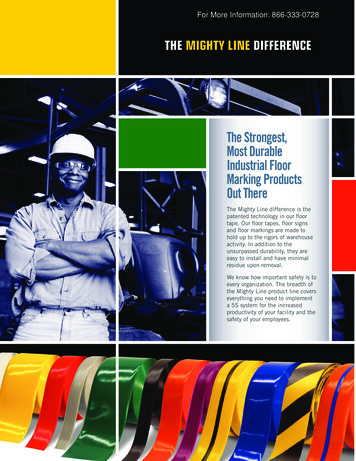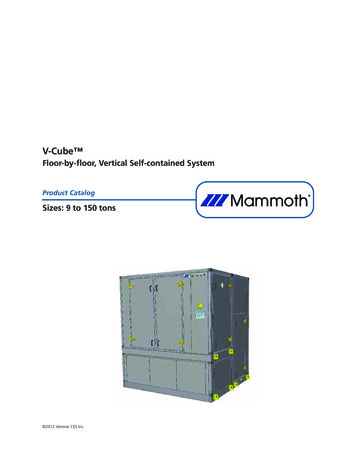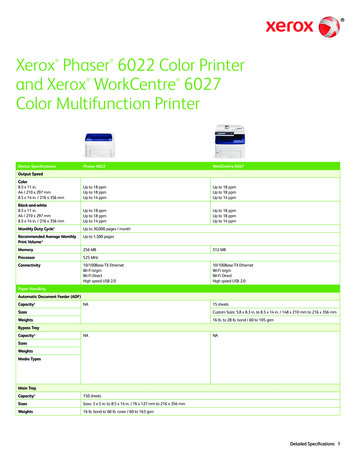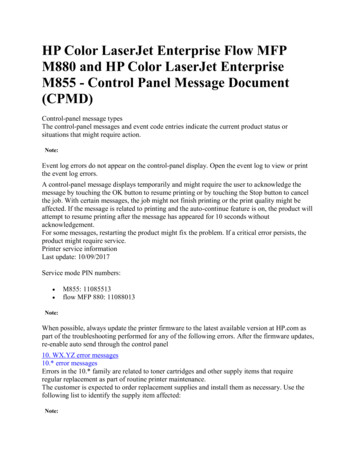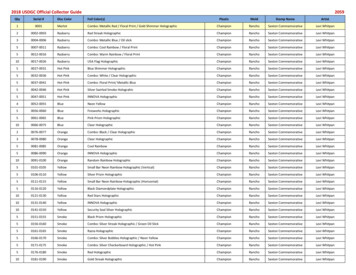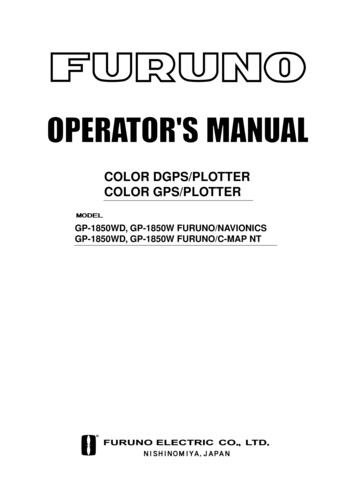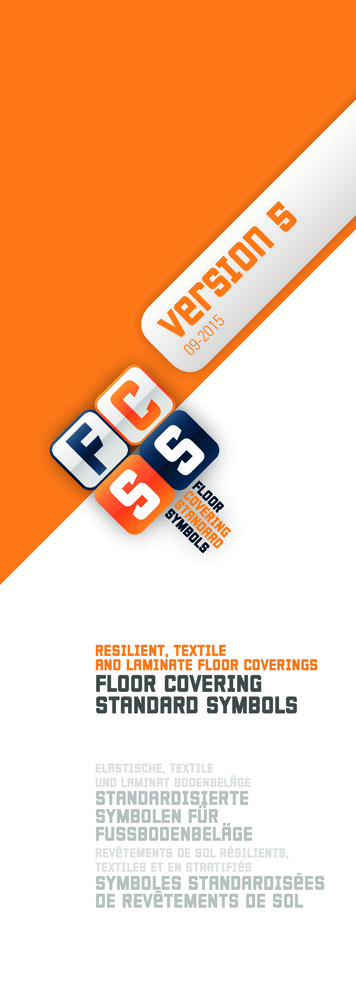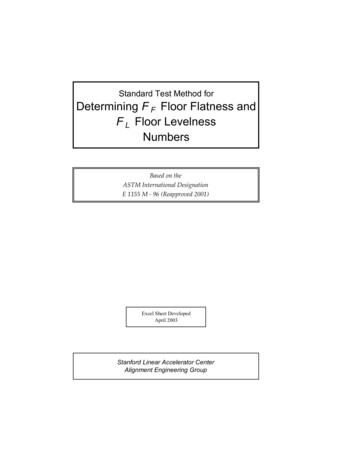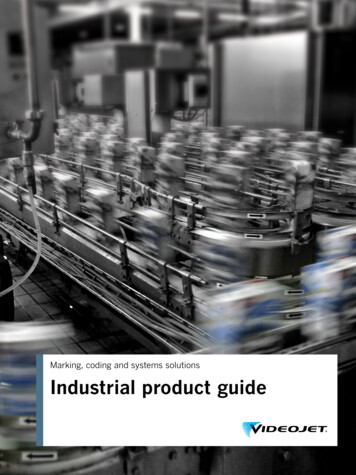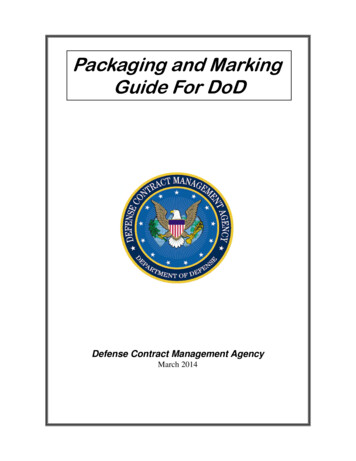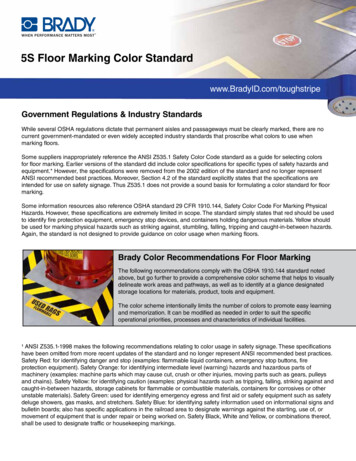
Transcription
5S Floor Marking Color Standardwww.BradyID.com/toughstripeGovernment Regulations & Industry StandardsWhile several OSHA regulations dictate that permanent aisles and passageways must be clearly marked, there are nocurrent government-mandated or even widely accepted industry standards that proscribe what colors to use whenmarking floors.Some suppliers inappropriately reference the ANSI Z535.1 Safety Color Code standard as a guide for selecting colorsfor floor marking. Earlier versions of the standard did include color specifications for specific types of safety hazards andequipment.* However, the specifications were removed from the 2002 edition of the standard and no longer representANSI recommended best practices. Moreover, Section 4.2 of the standard explicitly states that the specifications areintended for use on safety signage. Thus Z535.1 does not provide a sound basis for formulating a color standard for floormarking.Some information resources also reference OSHA standard 29 CFR 1910.144, Safety Color Code For Marking PhysicalHazards. However, these specifications are extremely limited in scope. The standard simply states that red should be usedto identify fire protection equipment, emergency stop devices, and containers holding dangerous materials. Yellow shouldbe used for marking physical hazards such as striking against, stumbling, falling, tripping and caught-in-between hazards.Again, the standard is not designed to provide guidance on color usage when marking floors.Brady Color Recommendations For Floor MarkingThe following recommendations comply with the OSHA 1910.144 standard notedabove, but go further to provide a comprehensive color scheme that helps to visuallydelineate work areas and pathways, as well as to identify at a glance designatedstorage locations for materials, product, tools and equipment.The color scheme intentionally limits the number of colors to promote easy learningand memorization. It can be modified as needed in order to suit the specificoperational priorities, processes and characteristics of individual facilities.¹ ANSI Z535.1-1998 makes the following recommendations relating to color usage in safety signage. These specificationshave been omitted from more recent updates of the standard and no longer represent ANSI recommended best practices.Safety Red: for identifying danger and stop (examples: flammable liquid containers, emergency stop buttons, fireprotection equipment). Safety Orange: for identifying intermediate level (warning) hazards and hazardous parts ofmachinery (examples: machine parts which may cause cut, crush or other injuries, moving parts such as gears, pulleysand chains). Safety Yellow: for identifying caution (examples: physical hazards such as tripping, falling, striking against andcaught-in-between hazards, storage cabinets for flammable or combustible materials, containers for corrosives or otherunstable materials). Safety Green: used for identifying emergency egress and first aid or safety equipment such as safetydeluge showers, gas masks, and stretchers. Safety Blue: for identifying safety information used on informational signs andbulletin boards; also has specific applications in the railroad area to designate warnings against the starting, use of, ormovement of equipment that is under repair or being worked on. Safety Black, White and Yellow, or combinations thereof,shall be used to designate traffic or housekeeping markings.
5S Floor Marking Color StandardUseYellowWhiteBlue, greenand/or blackOrangeRedRed & whiteBlack & whiteBlack & yellowAs the border color for:Aisleways, traffic lanes and work cellsEquipment and fixtures (workstations, carts, floor stand displays, racks, etc.)not otherwise color codedMaterials and components, including raw materials, work-in-progress andfinished goodsMaterials or product held for inspectionDefects, scrap, rework, and red tag areasAreas to be kept clear for safety/compliance reasons (e.g., areas in front ofelectrical panels, firefighting equipment, and safety equipment such as eyewashstations, safety showers and first aid stations.)Areas to be kept clear for operational purposes (not related to safetyand compliance)Areas that may expose employees to special physical or health hazards.Floor Marking Guidelines: Use as few colors as possible. This will make it easier for employees to remember the intended meaning of eachcolor and reduce the number of floor marking products that must be kept in inventory. C olor coding workcell and equipment borders. Some companies choose to mark equipment locations using thesame color employed for aisleways and work cell boundaries. This has the benefit of simplicity. However,consideration should also be given to the fact that the overall layout of lanes and sectors within the plant is made morevisually clear when different colors are used for these purposes. Color coding material storage areas. Use the same border color for all material storage areas unless there is animportant reason for differentiating between raw materials, work in progress and finished goods. As an alternative,consider using one border tape color in conjunction with different colored labels to visually distinguish between thevarious material types. Color coding non-material storage fixtures. Floor markings for fixtures such as racks that hold raw materials, work inprogress or finished goods should be color coded in green, blue and/or black. Otherwise use white or gray to mark thelocation of all other fixtures. C olor coding areas to be kept clear for safety and compliance. Some companies use red or red-and-white stripesin front of firefighting equipment, and green or green-and-white stripes in front of safety equipment. For simplicity sake,however, we recommend standardizing on one color for all applications where the intent is to keep the area in front ofequipment clear for safety or compliance reasons. That said, we also recommend that the firefighting and safetyequipment itself - as well as any associated wall signage - be color coded using red and green, respectively, to enhancevisibility and facilitate easy location of the equipment from a distance. Color coding areas in front of electrical panels. Under this standard, red and white should also be used to mark thefloor in front of electrical panels. Some facilities use black and yellow to indicate the presence of an electrical hazard,but the primary purpose of the marking is to keep the area in front of the panel clear. Danger labels should bedisplayed on the outside of the panels to warn employees of potential shock and arc flash hazards. Color coding operational “keep clear” areas. Use black and white marking to indicate that an area should be keptclear for operational reasons, such as ensuring sufficient clearance for forklifts. As objects without a home tend tonaturally congregate in open areas, employ black and white marking to discourage the use of open floor space forunintended purposes. C olor coding hazardous areas or equipment. Black and yellow striped marking should be used as a border aroundany area or piece of equipment where employees may be inadvertently exposed to a special hazard. For example, useblack and yellow borders around flammable or combustive material containers. The intent of the black and yellowborder is to indicate that special caution should be exercised when entering and working in the area.
ExamplesAisleways & traffic lanes(yellow)Work cells(yellow)Equipment(white)Material storage areas (green, blue and/or black)QA inspection (orange)Keep clear – operational(black/white)Defects/scrap/rework (red)Keep clear – safety(red/white)Hazard area(black/yellow)
ToughStripe Floor Marking TapeThe most durable adhesive-based floor marking solution on the market! Test-proven to withstand forklift traffic better than the leading competitorsEasy application system makes laying smooth, straight lines a one-person jobHigh gloss surface looks great and cleans up easily with common cleanserComes in a variety of colors and shapes, including prespaced dashes and dotsAlso available as floor signs and as label media for use in Brady label printersToughStripe material also runs through Brady GlobalMark 2 & BMP 71 printers, allowing you tocreate durable floor labels onsite and on demand!See next page for more information on Brady label printers.Toolboard & Workbench Marking Supplies Self-adhesive vinyl sheets and tapes designed for use on tool boards, work benches,storage shelves and other non-floor surfaces. Stick securely to a wide range of surface types Won’t peel, crack or fade when exposed to common cleansers, solvents or sunlightQuickly create tool shadows to exact size and shape usingBrady’s shadow vinylCreate durable rectangular borders using Brady markingtape and corner marksFor more information on Brady’s visual workplace solutionsvisit: www.BradyID.com/visualworkplace.
Brady Label PrintersBrady label printers are essential tools for creating a visual workplace. Designed for industrial use,both printers and the labels created on the printers are designed to withstand harshindustrial environments.Using labels together with 5S borders ensures that items are easily returned to their proper place.Printer SpecificationsTape WidthBuilt-in Display withkeyboardPC ConnectivityPlotterColorMedia TypesThe UltimateVisual WorkplaceSystemTHE PERFECT 5SLABEL PRINTERGlobalMark 2Industrial LabelerBBP 31 Sign& Label PrinterPowerMark Sign& LabelerMiniMark Industrial LabelerBMP 71Label PrinterBMP 21Label Printer½” - 4”½” - 4¼”4” - 10”½” - 4”¼” - 2”3/8” - ¾”YesYesYesNoYesYesYesYes (Color & cut only)Multiple Spot andProcess ColorsIndoor/outdoor vinyl,Repositionable vinyl, Poly tagstock, Magnetic, Reflective,Phosphorescent, TamperResistant, Metalized polyester,and more.Yes and Stand AloneNoYesNoYesNoYesNoNoNoSingle Spot ColorMultiple Spot ColorSingle Spot ColorSingle Spot ColorSingle Spot ColorIndoor/outdoor Vinyl,Tag Stock, Reflective,Phosphorescent,Repositionable Vinyl, RaisedEquipment Labels & more.Indoor/outdoor vinyl,Polytag stock, Reflective,Phosphorescent, Polyester,and more.Indoor/outdoor vinyl, Tamperresistant, and more.Indoor/outdoor vinyl,Repositionable vinyl,Economy polyester,Reflective, Tamper resistant,Raised panel, Wire & cablemarking.Vinyl, Self-laminating,Sleeves, Polyester, Wire &cable markingTHE PORTABLELEAN LABELERAll-In-One 5S Marking KitsEverything you need to 5S your facility in one kit!Brady’s 5S Marking Kits provide everything you need to getstarted 5S’ing and color-coding your facility. Each kit containsan assortment of our most popular floor and workbench markingsupplies. Kits that include a Brady portable label printer arealso available.Kits Contain:Floor marking (1 roll each of yellow, red, blue, green) 2” floor marking tape (4 rolls) 2” L-shaped corner marks (4 rolls)Toolboard / workbench markingKit with IDXPERT “Continuous Only” Label Printer: IDXPERT Label Printer Hard carrying case AC power adaptor 5 tape cartridges of various widths and colors(1 roll each of black, red, blue, green) 12” shadow vinyl (4 rolls)½” border tape (4 rolls)½” L-shaped corner marks (4 rolls)Kit with BMP 71 Label Printer: BMP 71 Label Printer Hard carrying case Charger / AC power adaptor 2” black and red ribbons (1 roll each) 5 rolls of tape of various widths and colorsFor more information visit: www.BradyID.com/visualworkplace.
Visual-Lean eLearning CoursesBrady’s Visual Workplace eLearning courses take the time and hassle out of training employees inlean concepts such as Visual Workplace, 5S Workplace Organization and Total Productive Maintenance.No more time wasted preparing training materials or repeating the same training presentations overand over again! Employees can take the courses when they want and at their own pace, from anyinternet-enabled computer.Each course emphasizes the proper use of visuals to reinforcestandards, identify abnormalities and sustain improvements.Hundreds of photo examples are included to help stimulate ideasand self-initiative on the shopfloor. 24-hour course access via internet Each course takes approx. 30 minutes to complete Real-life application scenarios keep learners engaged Learning checks and quizzes ensure proper comprehension Progress and performance reporting available for managers3 Courses Available1. Introduction To Visual WorkplaceShows how visuals support lean initiatives by eliminating waste, establishing operationalstability and sustaining continuous improvement. The second half of the course provides detailedbest practices for creating and maintaining visuals.2. Visual 5S – Optimizing Workplace OrganizationProvides a general overview of 5S and shows how 5S visuals can be used to maintain order andoptimize efficiency.3. Visual TPM – Enhancing Equipment Reliability & Maintenance EfficiencyProvides a general overview of TPM and shows how TPM visuals can be used to simplifymaintenance and detect equipment problems before they result in breakdowns.How to Order eLearning CoursesLog on to www.BradyID.com/eLearning and simply add thecourse to your shopping cart! After purchasing, you willreceive an email with a link to access your online course.Volume Pricing AvailableBe sure to ask about discount pricing for 10 or moretraining seats!Part No.142256142257142258142259DescriptionIntroduction to Visual WorkplaceVisual 5S: Optimizing WorkplaceVisual TPM: Enhancing Equip.3-course BundlePrice 29.95 29.95 29.95 49.95Learn more at www.BradyID.com/elearning.
The color scheme intentionally limits the number of colors to promote easy learning and memorization. It can be modified as needed in order to suit the specific operational priorities, processes and characteristics of individual facilities. ¹ ANSI Z535.1-1998 makes the following recommendations relating to color usage in safety signage. These specifications

